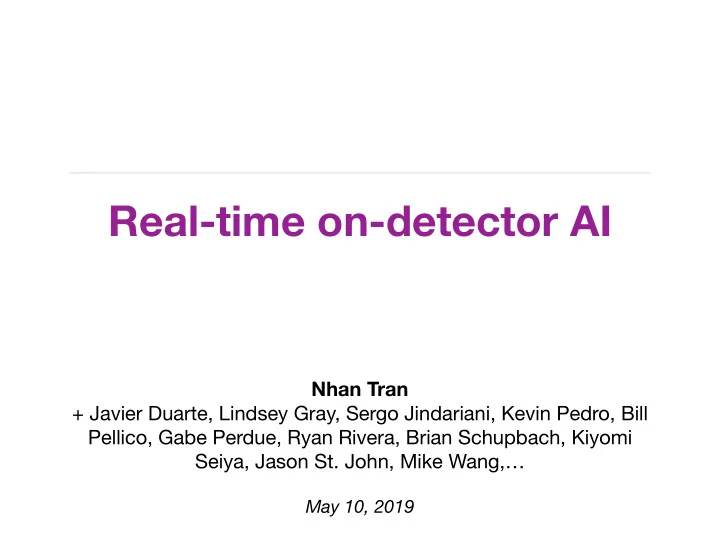

Real-time on-detector AI Nhan Tran + Javier Duarte, Lindsey Gray, Sergo Jindariani, Kevin Pedro, Bill Pellico, Gabe Perdue, Ryan Rivera, Brian Schupbach, Kiyomi Seiya, Jason St. John, Mike Wang,… May 10, 2019
CMS EVENT PROCESSING 2 Compute Latency CMS Trigger 1 ns 1 ms 1 s 1 us 1 kHz 100 kHz 1 MB/evt High-Level L1 Trigger 40 MHz Offline Trigger Offline CPUs CPUs FPGAs ML ML
CMS EVENT PROCESSING 3 Compute Latency CMS Trigger 1 ns 1 ms 1 s 1 us 1 kHz 100 kHz 1 MB/evt High-Level L1 Trigger 40 MHz Offline Trigger Offline CPUs CPUs FPGAs ML ML ML FPGAs FPGAs
CMS EVENT PROCESSING 4 Compute Latency CMS Trigger 1 ns 1 ms 1 s 1 us 1 kHz 100 kHz 1 MB/evt High-Level L1 Trigger 40 MHz Offline Trigger Offline CPUs CPUs FPGAs ML ML ML FPGAs FPGAs A whole other talk, mostly for computing group https://arxiv.org/abs/1904.08986
CMS EVENT PROCESSING 5 Compute Latency CMS Trigger 1 ns 1 ms 1 s 1 us 1 kHz At > ~1ms (network 100 kHz 1 MB/evt switching latencies), this hits ML the domain of CPU/GPU and you’re better off going High-Level L1 Trigger to industry tools. 40 MHz Offline Trigger Offline FPGAs But… - no time for CPU CPUs CPUs ASICs - heavy calculation - high throughput ML ML ??? Custom real-time detector FPGAs FPGAs AI applications are for you!
H IGH RATE AND INTELLIGENT EDGE 6 O(50-100) optical transceivers running at ~O(15) Gbs FPGA Traditionally, FPGAs programmed with low-level languages like Verilog and VHDL High level synthesis (HLS) New languages C-level programming with specialized preprocessor directives which synthesizes optimized firmware; Drastically reduces development DSPs (multiply-accumulate, etc.) Flip Flops (registers/distributed memory) times for firmware LUTs (logic) Block RAMs (memories)
( NON - LINEARITY ) O j = Φ(I i × W ij + b j ) Φ = ACTIVATION FUNCTION → → ↔ → N EURAL NETWORKS AND LINEAR ALGEBRA 7 N m N 1 N M M hidden layers output layer input layer layer m
Quantization, Compression, Parallelization made easy with hls4ml! PROJECT OVERVIEW 8 ������ ����������� �������� ����������-���/����� � hls 4 ml ����� ����������� ����� ����� ����� �������-�� ������� ��������-������� ���-�� ����������-��������-���� ������������/���� ���������-�����-�� ����-�-���� ����� �-���-�� Results and outlook: 4000 parameter network inferred in < 100 ns with 30% of FPGA resources! Muon pT reconstruction with NN reduces rate by 80% Larger networks and different architectures actively developed (CNN, RNN, Graph)
T ECH TRANSFER 9 LDRD: Add “reinforcement learning” to improve accelerator operations Tuning the Gradient Magnet Power Supply (GMPS) system for the Booster will be a first for accelerators and critical for future machines A first proof-of-concept, could apply across the accelerator complex
F UTURISITIC IDEAS 10 + Registers Photonics Control + + CPUs GPUs Unit (CU) ASICs Arithmetic FPGAs Logic Unit + + + + (ALU) FLEXIBILITY EFFICIENCY
ASIC S 11 Edge TPU
F RANKENSTEINS 12 Xilinx Versal
P HOTONICS 13 Even faster — a neural network photonics “ASIC” Recently fabrication processes have become more reliable In contact with 2 groups (MIT, Princeton) on possible photonics prototypes
S UMMARY 14 Real-time AI brings processing power on-detector Improves losses in efficiency/performance for triggers - gains back physics Other physics scenarios? A lot of efficiency loss from high bandwidth systems… Want to demonstrate helps with automation and efficiency of system operation Futuristic technologies could bring even more front end processing power Hardened vector DSPs, electronics and photonics
Recommend
More recommend